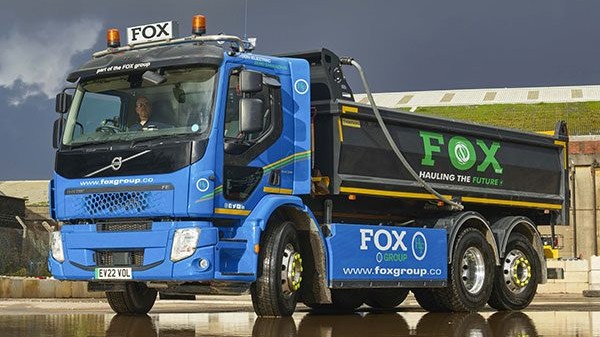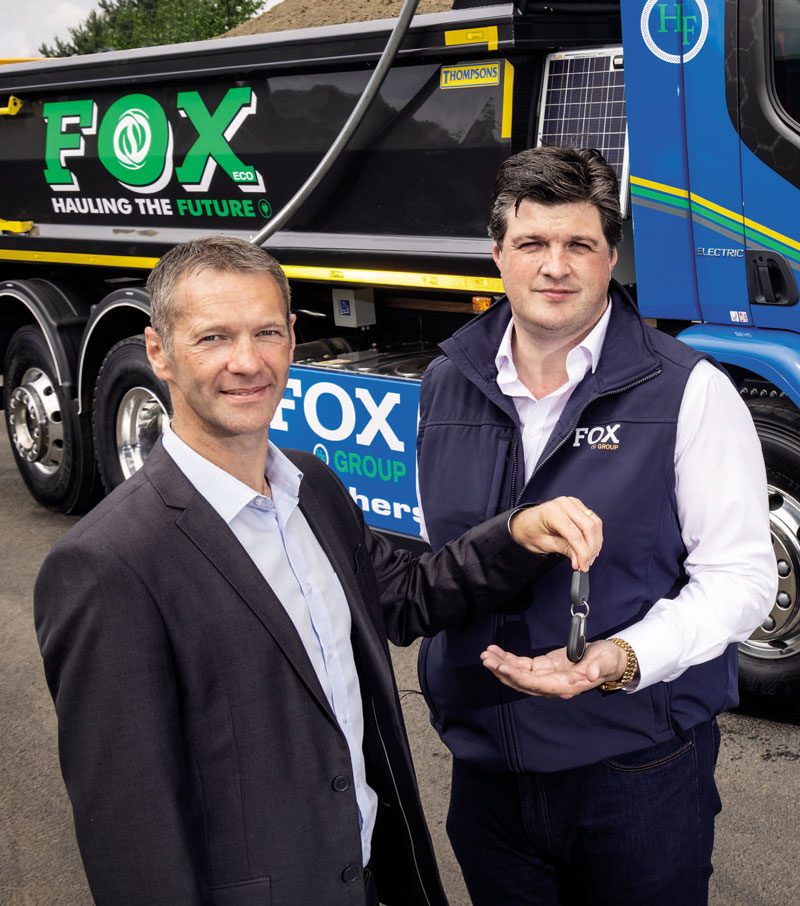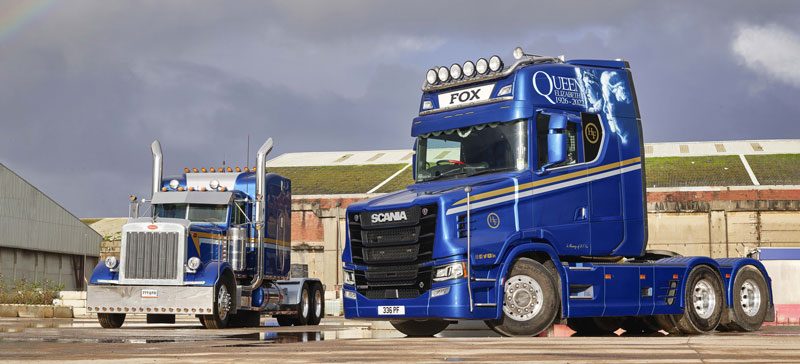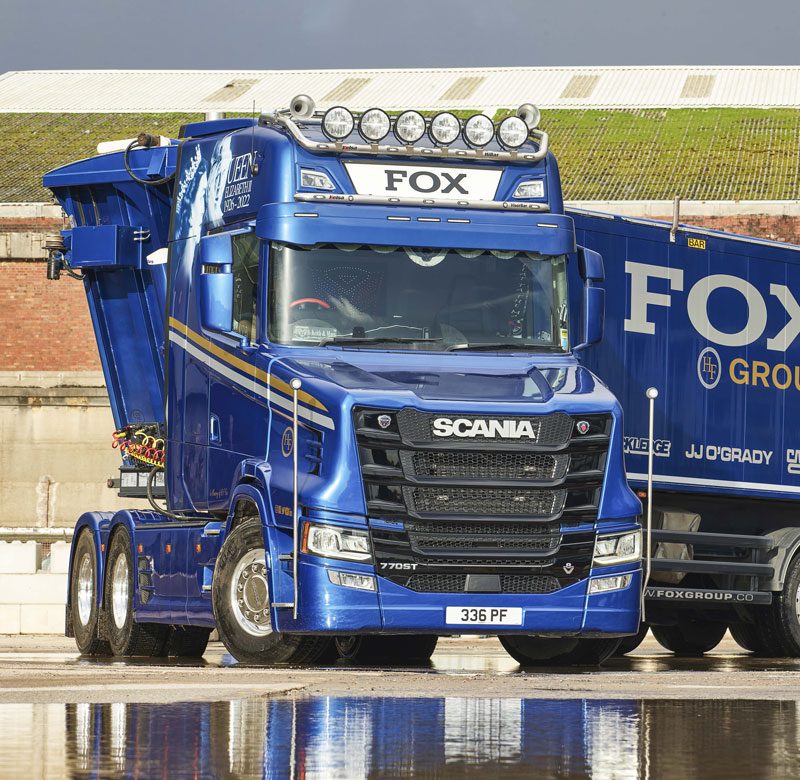
Will Shiers talks to a British operator with two battery-powered Volvo tippers to discover whether he’s living the electric dream or trying to wake from a shocking nightmare
In mid-2022, family-run haulage and plant-hire firm Fox Brothers made headlines in Britain when it put two Volvo FE Electric 6×2 tippers on the road. Based in Blackpool, in the northwest of England, it was the first company in Britain to do so and only the second in Europe. When I met up with CEO Paul Fox in June last year, shortly after taking delivery of the pair, he was bullish about the trucks. Fox Brothers was already running some electric plant, and he didn’t expect the trucks to pose too many difficulties. However, several months later, he says the experience has been a steep learning curve.
One of the key issues has been with the trucks’ maximum range, which has fallen short of initial expectations. When ordering them, Paul explained that they would be required to do seven loads a day within a 32km (20 miles) radius of its Leyland site, and the tippers were specified accordingly. He has since discovered that while they can do this on a single charge, the conditions must be perfect. Throw in some unfavourable variables, such as hills and poor weather conditions, and the range reduces dramatically.
“Running 20 miles into the Ribble Valley [steep inclines] burns a lot more juice than 20 miles to Southport [flat terrain],” explains Paul. “And if it’s raining, the wipers, heater and lights draw massively.” Sometimes the trucks are on charge by 1pm, having done just a few jobs. “It’s far from perfect, and it causes issues in the planning office because there are outstanding loads, and we have to swap things around,” he adds.

Another drawback to running electric trucks is the eye-watering up-front cost. These particular tippers had NZ$630,000 price tags, so they were roughly three times as expensive as comparative diesel-powered tippers. What’s more, being 6x2s they have a GVW of 27 tonnes, so they don’t have the same revenue-earning potential as the 32-tonne GVW 8x4s on the fleet. Considering this, Fox thinks the industry is far from seeing cost parity between battery-powered and diesel-powered trucks.
“If a business model was made around a fleet of these, it would not work. Not a chance!” he says. “But we’re lucky enough to be in a position where the business can afford it.”
Of course, the company was aware of the economics before placing the order – the only surprise being the rising cost of electricity.
A further issue is ground clearance. The batteries are low to the ground, limiting access to certain sites and causing headaches for planners. Drivers also must be mindful of the issue.
And now for Paul’s biggest concern of all – charging. Some initial issues were rectified with the help of supplying Volvo dealer Thomas Hardie Commercials. But Paul is less impressed with Britain’s electricity and gas utility company, the National Grid. Wanting to plan ahead, he’s enquired about fitting four additional chargers at the Leyland site where the electric tippers are based, enabling six electric trucks to be charged at once. However, for this to happen, he must first pay between NZ$75,000 and NZ$95,000 to upgrade the electricity supply. Initially, he wanted to future-proof the site with 20 chargers but was told that this wasn’t even possible yet. “We run about 300 trucks, and at a weekend, we have about 160 wagons at Leyland. Just imagine trying to charge that lot,” he says.

Not only has Paul discovered that the British charging infrastructure isn’t currently ready, but he has serious doubts whether it will be ready in the next decade. He believes there’s a huge disconnect between what he’s reading in the press and watching on television and what’s happening in the real world.
“People don’t know how far behind the infrastructure is. Not only are we talking about different pages of the book, but totally different chapters too,” he warns. “We have 300 trucks on the road. It would be a mammoth task to electrify them all, and I can’t see it happening within the next 10 years. There’s more chance of me winning the lottery three times in a row!”
But electric tippers have brought some definite pros to the business, not least the environmental benefits. The Fox Group is on a drive towards carbon net zero, and in recent years, has made several green investments.
“But if someone tells you that they’re buying electric trucks purely for that [environmental] reason, then they’re hypocrites,” he declares. “Yes, it’s good to be doing something for the environment and the community, and it’s great to be heading in the right direction, but the main drivers are positive publicity and your CSR [corporate social responsibility] and ESG [environmental, social and governance] scores.”

Their arrival in the fleet shows that the Fox Group is taking the environment seriously and is ahead of the curve. This hasn’t gone unnoticed by some of Britain’s largest contractors, who are eager to have the electric trucks on site, allowing them to tick a box in their own carbon net-zero policies. “We’ve learned that there is a drive within the construction industry [for carbon net zero], especially among tier one and tier two contractors, and it’s started to fall into the tendering process,” he explains.
So, having weighed the pros and cons, does Paul regret being an electric truck pioneer?
“Absolutely not. We are fully committed to electric vehicles,” he confirms.
In fact, he has placed an order for two Volvo FMX Electric 8×4 Tridem tippers, for delivery later this year.
He adds: “There’s a lot of hype surrounding the arrival of electric vehicles. Well, they’re not coming… they’re already here. You can see it in the car industry; wagons are a natural progression. You have to embrace it and take the jump. Unless somebody takes a leap of faith, nobody will. It’s a learning curve. It’s the first step on a very long ladder.”

SCANIA ST770
In complete contrast to the electric tippers (and considerably cheaper to purchase) is Fox Group’s flagship bonneted Scania ST770. The stunning truck, which went on the road last autumn, was built by Netherlands-based Vlastuin. While Scania no longer offers a factory-built bonneted truck, this specialist customiser converts new- generation S-series into T-series.
Paul Fox tells me it was purchased for Fox Brothers driver Keith Thirsk. Paul initially toyed with the idea of buying him a used 2018 Scania S650 Highline but was put off by the price tag. Knowing how well Vlastuin-built T-cabs hold their value, he figured it would make more sense to spend additional money on a new one instead. “Well, that’s what I convinced myself anyway,” he says.
The truck came highly spec’d, including polished alloys, chequer plate catwalk, twin stacks and an illuminated V8 logo on the outside back wall. Fox added Kelsa light bars and stunning metallic paintwork. The final touch was dedicating it to the late Queen Elizabeth II, with artwork supplied by local firm WTS Commercial.
The truck, which is coupled to a STAS bulk tipping trailer, is used to haul 10mm and 20mm aggregates from Fox Brothers’ quarry in Anglesey, North Wales, to various asphalt plants.
PETERBILT 379
While Fox Brothers is undoubtedly a forward-thinking company, it also embraces its past. A fine example is the company’s 1992 Peterbilt 379 show truck, which is dedicated to Paul Fox’s late grandfather Harold (better known as Barney), who passed away in 2007.
Paul purchased the Cat C12- powered 6×4 tractor in early 2014. “I’d been looking for one for two or three years, and then I found this one,” he explains. “When I bought it, there were cows airbrushed all over it, and the interior was awful.”
Over the next couple of years, it underwent some major work, including a complete respray. “It’s sort of in company colours. Our wagons have always been Traffic Blue, with an orange and grey stripe. Whereas this is dark metallic blue with a gold and silver stripe. We also did some chrome work on it and redid the interior,” he says. The finishing touches were an airbrushed image of Barney and pictures of some of the trucks, cranes and plant purchased during his era.
Read more
Winter warriors
0 Comments12 Minutes
From our travels
0 Comments1 Minute
Maximum nostalgia
0 Comments5 Minutes
Meeting Volvo’s VNL
0 Comments13 Minutes







